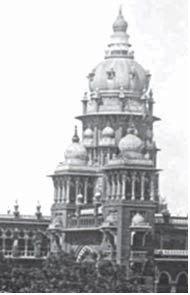Registered with the Registrar of Newspapers for India under R.N.I 53640/91
Vol. XXV No. 22, March 1-15, 2016
Creating Madras’s 2nd lighthouse
by Dr. A Raman
Before launching on the construction of the lighthouse, Smith did his homework thoroughly. He impresses by the clarity he had with regard to the context of his project and by his adeptness in matching his task with local soilscape and other relevant factors, such as climate. With regard to the light apparatus, he explains the modifications he thought of earlier and made later in the construction of the lamp by substituting plated reflectors for brass reflectors and by increasing the size of each reflector used to reduce their numbers and, thus, their load. He elaborately explains the design of the lantern (referred to as ‘frame’) to achieve a superior compactness and strength, and to enable easy access to various parts situated within it for service and maintenance. He had thoroughly examined and weighed advantages and benefits against disadvantages and weaknesses on using a French dioptric apparatus and oil.

Third lighthouse’s location – in the same campus as the second’s
Stone-tower design was the most popular design for lighthouses in the 19th Century, although a few around the world were constructed using timber and iron, not having the tower design. Therefore, a stone-tower design chosen by an experienced civil engineer such as Smith does not surprise. Due to strong winds and periodical cyclonic rains along the coast of Madras, Smith decided to use the best, locally available rock material, Charnockite. In other parts of the world, lighthouses were mostly built using rock materials such as limestone. I could not access any of the drawings and notes made by him, when he built the column. I guess that he must have followed the design used by John Smeaton, while building the Plymouth lighthouse, which involved the interweaving of rock blocks, reinforced with dovetail joints and marble dowels. Moreover, the then contemporary civil-engineering practice recommended using rock materials in such edifices rather than bricks, since the bricks were considered less amenable in achieving a circular shape.
The next need then was to fix the light with the same degree of brilliance of a revolving light as proposed by Fresnel. Fresnel’s concept advanced that each of its concentrated pencils of rays of a revolving light would fall successively on the eyes of the viewer, principally with no gap from wherever it was viewed.
Smith favoured using a gas – oxy-hydrogen – flame. Burning oxy-hydrogen gas as a light-generating source (also known as the ‘koniophostic light’, ‘Drummond light’, lime light’) was then popular as a useful energy source for use in lighthouses. The new lantern (interior diameter of 9’ [2.74 m], height 4’ 6″ [1.35 m], with a pyramid roof, surmounted by a cowl) – meant for placing atop the Madras lighthouse – was a 12-sided gun-metal object, of which nine sides were transparent and the rest were blinded with copper sheets. An exterior balcony enabled cleaning of this. The skeleton of the lantern was made of iron and the rest of the fittings with wood. The upper curb of the lantern frame included an iron cross, which carried a plate and friction rollers supporting the spindle of the frame. The lantern also included eight small and eight large air vents that could be either closed or opened from within the lantern.
The novelty of Smith’s apparatus was the reciprocating motion to the lamp, making it glide and re-glide over 90o. Comparing the strengths of a fixed light against a revolving light, Smith argues that in the fixed light, the effect produced is precisely proportioned so that none of the light is lost, since none of the reflectors is directed inland; in a revolving light, on the contrary, provided the revolution is completed, a part of the light is expended with no purpose. The revolving light, however, has been found useful in many instances, since it is only by a series of flashes and eclipses succeeding in a determined order, that the particular lights on a thickly-studded coast can be recognised from each other. Therefore, Smith proposed “in places where lighthouses are not numerous, to stop the revolution of the apparatus after a certain portion of the circumference has been traversed and then to reverse the motion so as to cause the light to reciprocate. The action of the reflectors is thus confined to the sea-side only. By this means a light may be obtained at five-eighths of the expense usually incurred,” which was effected in Madras by him in 1838-1839.
The lantern (or the frame, as described by Smith) does not exist at the top of the Doric column lighthouse today; only a top-vacant column remains today as a ‘protected monument’ with the Department of Archaeology, Government of India.
In 1894, the Government saw the need for a taller lighthouse than the Doric column lighthouse and favoured creating a new one. The third lighthouse had its lantern placed atop the Madras High Court’s tallest dome. Was the reciprocating-motion lantern designed by Smith moved to the new (third) lighthouse in 1894? Or was it dismantled?
(Concluded)

